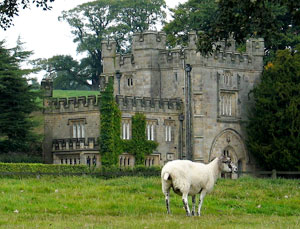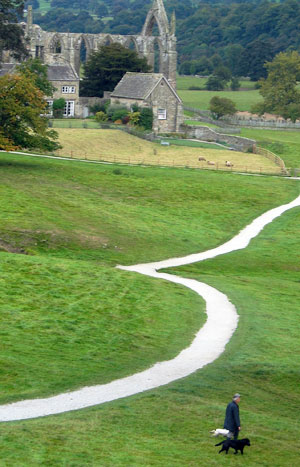KETTLEWELL, ENGLAND – Long before Helen Mirren became the queen of our hearts with her Academy Award-winning portrayal of the British monarch in The Queen, she already ruled the silver screen thanks to her many other excellent performances. One of her most memorable was in the delightful flick Calendar Girls.
In that movie, Mirren and fellow screen veteran Julie Walters, helped immortalize a group of middle-class women from England’s Midlands, who bared their middle-aged midriffs (and a lot more) on a now legendary calendar to raise money for a local hospital.
The movie also raised awareness of the Midlands and its quaint Yorkshire towns and ancient sites as a prime tourist destination. And tourists have been beating a path there ever since.
Movie tourism, as it has become known, accounts for a major part of the industry in places like Britain, France and Italy. Inspired by film classics like Harry Potter, the De Vinci Code, Chocolat, Calendar Girls and many others, fans want to see the places where their favourite movies were filmed.
So, with that in mind, I packed up and headed for the amazing Yorkshire Dales, that beautiful patch of rolling landscape - much of it now designated a national park - which served as a backdrop for Calendar Girls and many other British movies and television shows.
Using the small Yorkshire town of Bolton Abbey and its fabulous five-star hotel owned by the Duke and Duchess of Devonshire, as my base, I charted a course to find the places, and hopefully some of the local characters, featured in the film.
Ironically, Rylstone, the women’s real hometown, was not used - it doesn’t have Hollywood good looks, apparently - so the charming hamlet of Kettlewell was a stand in.


Above: Historic landmarks and quaint country settings make England the perfect movie backdrop.
Following the narrow B6160 road, I first came across Burnsall, where some of the movie was shot. The small whistle stop town is where the Baker’s Dozen - the name members of the Calendar Girls group were known as - held one of their shows to raise money for the hospital.
It’s one of the most charming English towns you’ll ever see, where people pass time strolling the riverbank pushing prams with red-cheeked babies inside. A local couple offered to snap my photograph in front of the town’s ancient stone bridge, the one that offers travellers a wider alternate route to Appletreewick, another sleepy nearby Yorkshire town - not used in the movie, but well worth visiting.
Next stop: Grassington, where the town square is surrounded by quaint shops featuring hand-woven wool sweaters supplied from the sheep that graze on the emerald landscape leading to the town.
This is a place that plays a prominent role in the movie and one where you are tempted to linger and enjoy a pint at the old Grassington Hotel.
The narrow, twisting road leading to Kilnsey was a sober reminder that you might want to pass on the pint at this juncture.
"We are seeing benefits from the movie," said the lady in the Grassington convenience store where I purchased my copy of the calendar.
"Aren’t they lovely?" said the storekeeper as I peeled off the plastic covering and took my first look at Baker’s Dozen.
The mostly 50-something models have their naked bodies strategically hidden behind baked goods. The most striking was November, seen standing behind two large frosted buns with strategically-placed cherries on top.
The road leading to Kilnsey and Kettlewell is lined with stone fences that separate the perfectly groomed farms located in this part of charming Yorkshire, England’s outdoor playground where hikers are as plentiful as sheep.
Kilnsey and the Tennant Arms came into view first but it was too early for lunch - and besides, I had to come back this way to see other towns used in the movie - so I pressed on to Kettlewell, the pretty village made up of stone cottages that rests in a small valley with a lazy river running through it. It’s easy to see why the director of Calendar Girls picked this town as the women’s home base.
The narrow streets and neatly-kept homes of Kettlewell look like, well, a movie set. I stopped a man named Tim and asked which homes were used in the movie.
"That one there is the place where the main character (Mirren) and her husband lived," said the man, pointing to a handsome home behind a white picket fence.
"It’s actually for sale if you want to buy it," smiled Tim, who, without prompting, suggested we "turn back and go to the Tennant Arms for lunch.”
My mouth was watering by the time I entered the pub. Kilnsey, one of the few nondescript towns along the route, is noted for a park featuring large granite cliffs - from where much of the area’s stone fences originated - and a trout farm. Its only saving grace was the Tennant Arms, where I dined on Whitby fried shrimps - imported from the lovely coastal town located in the Yorkshire Moors - and washed them down with the pub’s finest lager.
After lunch I retraced my steps along the B6160 until I veered off on to the B6265 leading to Linton, one of two main locations - the larger city of Skipton was the other - used for the movie.
Before reaching Skipton, though, I stopped at the real Calendar Girls’ hometown of Rylstone and quickly realized why the movie wasn’t shot there. Even special effects couldn’t help this place.
I spent the rest of the afternoon meandering along back roads bordered by quaint pubs and small hamlets, any one of which could have served as a perfect backdrop for the film.
About the Author
Marc Atchison is a veteran journalist and a seasoned traveller with more than 20 years of travel writing experience. As the former Travel Editor of the Toronto Star, Canada's largest newspaper, and now Editor-in-Chief and Senior Writer for TraveLife magazine (Canada) and travelife.ca, Marc has been to over 100 countries in the world. Japan is one of his favorite destinations and he's been there on numerous occasions.